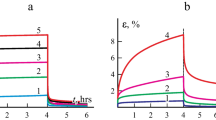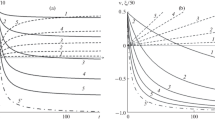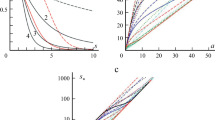Abstract
We study the nonlinear stress-strain constitutive relation proposed earlier for describing one-dimensional isothermal rheological processes in the case of monotonous variation of the strain (in particular, viscoplasticity, creep, relaxation, plasticity, and superplasticity). This relation contains integral time operators of the strain and strain rate, which are the norms in the Lebesgue and Sobolev spaces equipped with special weight factors, one material function, and nine material parameters determined by the results of tests of the material for relaxation, creep, long-term strength, and constant-rate strain.
We analytically inverse the constitutive relation and study the properties of the inverse operator. We derive the equation of creep curves corresponding to an arbitrary law of loading at the stage of passing from the zero stress to a given constant level. We study their dependence on the material parameters and the loading stage characteristics and find restrictions on the material parameters which ensure that the asymptotic behavior of the creep curves for large times is independent of the length of the loading stage and the specific law of stress variation during this stage, i.e., we find the conditions of the model memory decay in creep. Thus we have proved that the constitutive relation proposed above can adequately model both creep and the effect of the material memory decay.
Similar content being viewed by others
References
V. N. Kuznetsov, A. V. Khokhlov, and S. A. Shesterikov, “Constitutive Relations for Rheological Processes,” Electronic Journal “Investigated in Russia”, http://zhurnal.ape.relarn.ru/articles/2003/016.pdf, 152–160 (2003).
A. V. Khokhlov, “Constitutive Relation for Rheological Processes: Properties of Theoretical Creep Curves and Material Memory Decay,” in Proc. VI Intern. Symp. “Modern Problems of Strength” Dedicated to V. A. Likhachev (2003), Vol. 2, pp. 267–274.
A. V. Khokhlov, “Criteria for Creep Fracture Taking into Account the Strain History, and Simulation of Long-Term Strength Curves,” Electronic Journal “Investigated in Russia”, http://zhurnal.ape.relarn.ru/articles/2005/098.pdf, 1010–1020 (2005).
W. A. Dai, Thermodynamics of Simple Media with Memory (Mir, Moscow, 1974) [in Russian].
V. D. Klyushnikov, Physico-Mathematical Foundations of Strength and Plasticity (Isd-vo MGU, Moscow, 1994) [in Russian].
Yu. G. Basalov, V. N. Kuznetsov, and S. A. Shesterikov, “Constitutive Relations for a Rheonomous Material,” Izv. Akad. Nauk. Mekh. Tverd. Tela, No. 6, 69–81 (2000) [Mech. Solids. (Engl. Transl.)].
J. E. Fitzgerald and J. Vakili, “Nonlinear Characterization of Sand-Asphalt Concrete by Means of Permanent-Memory Norms,” Proc. of the SESA 30(2), 504–510 (1960).
R. A. Vasin and F. U. Enikeev, Introduction to Mechanics of Superplasticity (Gilem, Ufa, 1998) [in Russian].
O. V. Sosnin, B. V. Gorev, and A. F. Nikitenko, Energy Version of Creep Theory (Inst. Gidrodinamiki SO AN SSSR, Novosibirsk, 1986) [in Russian].
Yu. N. Rabotnov, Mechanics of Deformable Solids (Nauka, Moscow, 1988) [in Russian].
Yu. N. Rabotnov, Creep of Structural Members (Nauka, Moscow, 1966) [in Russian].
S. A. Shesterikov and M. A. Yumasheva, “Concretization of the Constitutive State in Creep,” Izv. Akad. Nauk SSSR. Mekh. Tverd. Tela, No. 1, 86–91 [Mech. Solids. (Engl. Transl.)].
D. V. Georgievskii, D. M. Klimov, and B. E. Pobedrya, “Specific Features of the Behavior of Viscoelastic Models,” Izv. Akad. Nauk. Mekh. Tverd. Tela, No. 1, 119–157 (2004) [Mech. Solids. (Engl. Transl.)].
A. V. Khokhlov, “An Extension of the Constitutive Equation for Rheological Processes and New Properties of the Theoretic Creep Curves,” in Advanced Methods in Validation and Identification of Nonlinear Constitutive Equations in Solid Mechanics (EUROMECH Colloquium 458) (Moscow, 2004), pp. 44–46.
A. V. Khokhlov, “Constitutive Relation for Rheological Processes with Known Loading History,” Electronic Journal “Investigated in Russia”, http://zhurnal.ape.relarn.ru/articles/2005/032.pdf, 355–365 (2005).
Author information
Authors and Affiliations
Additional information
Original Russian Text © A. V. Khokhlov, 2007, published in Izvestiya Akademii Nauk Mekhanika Tverdogo Tela, 2007, No. 2, pp. 147–166.
About this article
Cite this article
Khokhlov, A.V. Constitutive relation for rheological processes: Properties of theoretic creep curves and simulation of memory decay. Mech. Solids 42, 291–306 (2007). https://doi.org/10.3103/S0025654407020148
Received:
Issue Date:
DOI: https://doi.org/10.3103/S0025654407020148




